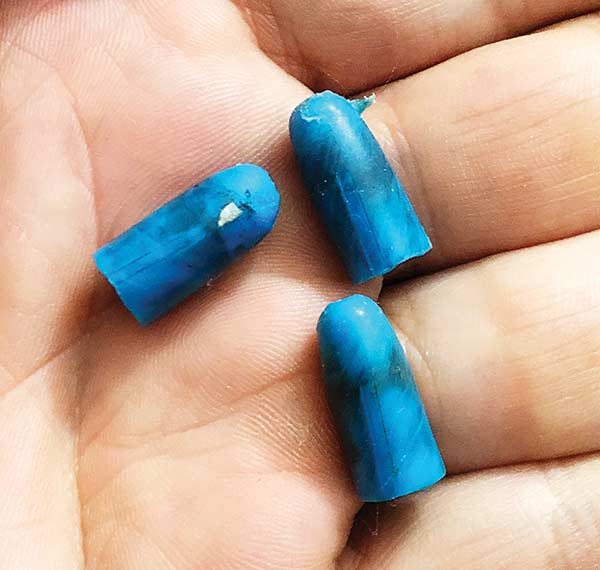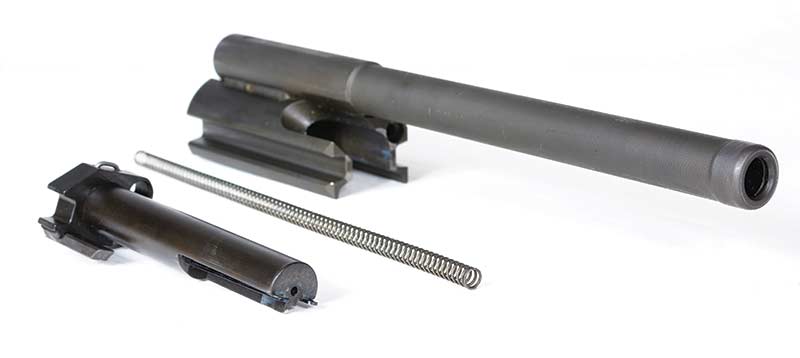The ammo shortage is no longer news and has sharply limited most of our ability to practice. Fortunately, this scarcity is not new to the military which has used things like subcaliber conversions for nearly a century. A .22 conversion was one of the first accessories developed for the M1911 and the U.S. military even adopted a floating-chamber .22 conversion for their belt-fed .30 machine guns — both, interestingly, designed by Dave “Carbine” Williams of M1 carbine fame. With its 0.223″ bore, the M16/AR15 was and remains particularly easy to convert. Alas, it’s harder for us who love the .308 as $0.50 a shot was a good price in normal times. But there is hope.
Millions of HK roller-locked G3 .308s (and its predecessor the CETME) were issued across the world and semiauto versions are common in the U.S., largely thanks to South Carolina’s PTR which purchased Portugal’s HK-licensed G3 tooling. They lead the U.S. industry in semiautomatic versions of the iconic .308, including producing receivers on an OEM basis for other makers.
Along with the very affordable Century Arms C308, PTR guns cost far less than original HK rifles such as the HK91, which goes for more than some cars I’ve owned. As many countries have moved to newer rifle designs, spare G3/CETME parts of all kinds have flooded the market, including two of particular interest to us — a rollerless bolt for plastic training ammo and a .22 rimfire unit.
Plastic Fantastic
Reportedly available in multiple colors for different applications, I’ve only ever seen the plastic ammo in blue. Basically a one-piece plastic case with a metal casehead, upon firing the powder charge separates the casehead and the bullet, sending the little plastic pill downrange at a blistering 4,000+ fps. Word to the wise: While not appropriate for hunting or self-defense, this is still a bullet and is fully capable of taking a life. Treat it like the lethal projectile it is. While no longer readily available, plastic training ammo was also made in 9mm, for which HK made a dedicated MP5. Sounds like fun, but I’m sure it costs more than my house.
As a safety feature, both the casehead and training bolt face for plastic ammo are slightly smaller in diameter than the usual .308 to keep the unlocked bolt from being able to fire full power ammunition. I fired several hundred rounds of the blue ammo using the training bolt or cycling them by hand in an unmodified C308 and a Ruger Scout rifle. In spite of the smaller casehead, there were no extraction issues.
Basic physics tells us a 9.9-grain bullet has little momentum and will slow quickly, so long-range accuracy with plastic bullets is not a thing. And while the limited recoil is a welcome reprieve, the cartridge’s low power cannot cycle the stock action. The simple solution is to manually cycle the bolt, which gets really old, or purchase the rollerless training bolt/carrier assembly.
.22 Adapter
Unlike the blue ammo training bolt which removes the locking element of the design, the .22 conversion has a smaller, lighter breechblock mounted in the carrier and powered by its own recoil spring. While the carrier is still used to manually load or unload, it does not reciprocate with recoil, which leads to one of the conversion’s quirks. While it only needs a short length of travel to cycle with .22 ammo, the carrier can still be drawn back the full length required for .308 rounds. When you do this, the carrier modifications required to make the smaller .22 round feed will cause it to get stuck behind the hammer where it will stay until you field strip the gun and fix it.
The wise .22 shooter will get a length of vacuum hose at the local car parts store, slit it and slide 2″ of it on the recoil spring guide rod to act as a stop to keep the carrier from coming back too far. Magazines are likewise a bit of a sore spot. The grey-bodied conversion mags have a separate .22 magazine bolted into place in a positioning block riveted into a steel .308 magazine. The internal .22 mag holds 20 rounds just like the big boy version and is surrounded by a standard .308 magazine spring, a bit of superfluity only serving to retain the magazine baseplate.
Two mags usually come with the conversion, but they are unobtanium if purchased separately and run around $200. Black Dog Machine, however, sells a magwell insert that will take their Uzi magazines: the insert and one mag are $25, while the insert alone goes for $10.
While mine feeds well, the standard or even high velocity .22 LR will not push the bolt back far enough to eject. This likely means hyper velocity ammo will be required, further reducing cost savings.
Installation
For those unfamiliar with the roller lock, both conversions are installed in the same way. After clearing the rifle, push out the two push pins holding the stock in place and slide the stock backwards off the receiver. Since, unlike the AR, the pins are not captive, feel free to stow them in the two holes in the stock provided for this purpose. Pivot the trigger housing downwards at the rear until it can be pulled off of its forward mounting point at the rear of the magazine well. Use the cocking handle to unlock the bolt carrier and remove the carrier from the rear. If installing the .22 conversion, insert the barrel liner into the bore prior to reassembly, which is in reverse order.
Testing
For semi-auto fire, I used the training bolt in a pair of PTR rifles, one a modified 16″ collapsible stock gun and the other a green-stocked GIR, a dead ringer for the Bundeswehr G3. In order to get the best out of the gun, I paired the GIR with Leupold’s VX Freedom AR scope. I mounted it in a pair of 30mm rings sourced from Brownells, mounted to an AR-style riser to get the scope up above the rear sight.
Assuming good magazines are used, the plastic training ammo ran flawlessly although malfunctions basically break the cartridge in half. The light recoil made it a joy to shoot. While there is some change in point of impact, my Scout Rifle with a 200-yard zero put them at point of aim at 100 yards. At this distance, groups tended to open up and when the bullets struck in the plywood target backer, most penetrated. Like I said, not a toy.
Blue ammo has gone in and out of stock through the years but as this is written, it’s still available online — as it has been throughout the pandemic — for under $200 per thousand.
The .22 conversion is somewhat less of a money saver. Running between $500–$600, the G3 .22 conversion comes in a wooden case with dividers to hold two magazines, the bolt, a barrel liner, a manual in German and the ubiquitous plastic cleaning kit.
For the coolness factor, it’s hard to beat the .22 unit. But you’ll pay for it and its ammo needs mean you won’t get the same savings as most rimfire conversions. The same money buys a training bolt and 2,500 rounds of blue ammo. Much as I’m a sucker for a rimfire, if you can only get one, it’s an easy choice.






